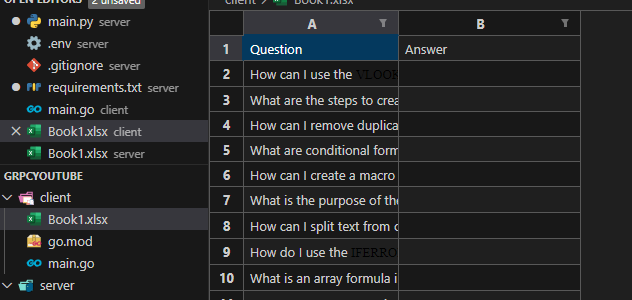Go 和 Python 之間的 gRPC 通信
- WBOYWBOYWBOYWBOYWBOYWBOYWBOYWBOYWBOYWBOYWBOYWBOYWB原創
- 2024-08-22 19:02:33955瀏覽

gRPC 是一個強大、高效能的遠端過程呼叫 (RPC) 框架,儘管不如 REST 常用,但在某些場景下具有顯著的優勢。
此外,它與語言無關,可以在任何環境中運行,使其成為伺服器到伺服器通訊的理想選擇。
我不會深入研究它的完整解釋,但這裡是 gRPC 的一般連結。我將提供實作教學
Go gRPC 用戶端
讓我們想像一下,我們的 Go 是客戶端,但對於前端應用程式 React、Svelte 等來說,它是伺服器。
func getFirstArg() (string, error) {
if len(os.Args) < 2 {
return "", fmt.Errorf("expected 1 argument, but got none")
}
return os.Args[1], nil
}
func main() {
filePath, err := getFirstArg()
if err != nil {
log.Fatalf("Failed to get file path from arguments: %v", err)
}
fileData, err := ioutil.ReadFile(filePath)
if err != nil {
log.Fatalf("Failed to read file: %v", err)
}
...
}

作為範例,React 前端上傳一個文件,Go 處理它,但我們需要來自 excel 的答案,我們將使用 GPT API。雖然可以用 Go 來完成,但 Python 有更多可以簡化我們生活的軟體包,例如 langchan_openai、pandas for excel 等等。
讓我們從安裝 gRPC 開始,最好是在您的 virtualenv .venv 中
$ go install google.golang.org/protobuf/cmd/protoc-gen-go@latest $ go install google.golang.org/grpc/cmd/protoc-gen-go-grpc@latest $ export PATH="$PATH:$(go env GOPATH)/bin"
接下來你應該在你的作業系統中安裝protocol buffer,可以按照這裡進行操作。
讓我們創建一個 proto 目錄,您將在其中存儲協議緩衝區文件,我將其命名為 excel.proto 並粘貼此:
syntax = "proto3";
option go_package = "client-gRPC/proto";
service ExcelService {
rpc UploadFile(FileRequest) returns (FileResponse);
}
message FileRequest {
string file_name = 1;
bytes file_content = 2;
}
message FileResponse {
bytes file_content = 1;
}
這個 gRPC 服務 ExcelService 允許客戶端透過傳送檔案名稱和內容來上傳檔案。伺服器以相同的文件內容進行回應。
對 Go 來說,在 Python 中傳入 go_package 是必需的,不需要這一行。
如果您使用 VSCode,vscode-proto3 是一個很好的擴展,值得下載。
完成所有這些之後,您可以生成原型文件,我更喜歡它與 prot 目錄處於同一級別,為此運行以下命令:
協定--go_out=. --go_opt=paths=source_relative --go-grpc_out=. --go-grpc_opt=paths=source_relative proto/excel.proto
如果成功產生兩個文件,如果需要進行大量調整,則可以選擇新增一個 Makefile 並將其定義為 proto + upper 命令。
import (
....
"google.golang.org/grpc"
pb "client-gRPC/proto"
"github.com/xuri/excelize/v2"
)
func main() {
....
conn, err := grpc.Dial("localhost:50051", grpc.WithInsecure())
if err != nil {
log.Fatalf("Failed to connect to gRPC server: %v", err)
}
defer conn.Close()
client := pb.NewExcelServiceClient(conn)
req := &pb.FileRequest{
FileName: filePath,
FileContent: fileData,
}
res, err := client.UploadFile(context.Background(), req)
if err != nil {
log.Fatalf("Failed to upload file: %v", err)
}
outputFile := "output.xlsx"
err = saveBytesAsExcel(outputFile, res.FileContent)
if err != nil {
log.Fatalf("Failed to save bytes as Excel file: %v", err)
}
fmt.Printf("Excel file saved as: %s\n", outputFile)
}
func saveBytesAsExcel(filePath string, fileContent []byte) error {
f, err := excelize.OpenReader(bytes.NewReader(fileContent))
if err != nil {
return fmt.Errorf("failed to open Excel file: %v", err)
}
if err := f.SaveAs(filePath); err != nil {
return fmt.Errorf("failed to save Excel file: %v", err)
}
return nil
}
我們建立一個連線來監聽 50051,它將成為我們的 Python 伺服器, &pb.FileRequest 是先前使用 proto 指令產生的,現在我們正在匯入方法。如果你跑步會收到?由於Python伺服器尚未建立。
Failed to upload file: rpc error: code = Unavailable desc = connection error: desc = "transport: Error while dialing: dial tcp 127.0.0.1:50051: connect: connection refused"
Python gRPC 伺服器
由於 python 將充當伺服器,因此方法會略有不同,但本質上不需要套件欄位中的相同原型檔案。讓我們先建立一個沒有 gRPC 的基礎 main.py,只是為了看一下 GPT 如何在 excel 中填充問題。
import os
import openai
import pandas as pd
from dotenv import load_dotenv
def get_answer_from_gpt(apikey: str, question: str):
openai.api_key = apikey
response = openai.ChatCompletion.create(
model="gpt-4",
messages=[
{"role": "system", "content": "You are a helpful assistant."},
{"role": "user", "content": question}
]
)
return response['choices'][0]['message']['content'].strip()
def answer_questions_df(df: pd.DataFrame, apikey: str):
answers = []
for question in df.iloc[:, 0]:
answer = get_answer_from_gpt(apikey, question)
answers.append(answer)
return answers
if __name__ == "__main__":
load_dotenv()
openai_api_key = os.getenv("OPENAI_API_KEY", "OpenAI API key hasn't been set.")
df = pd.read_excel('Book1.xlsx')
df['Answer'] = answer_questions_df(df, openai_api_key
這是一個簡單的腳本,可以回答 Go 發送給我們的問題,但由於專用的 openai 庫,LOC 較少,這使得它變得更容易。
我們首先新增具有與上面相同的檔案的原始目錄,可以按照討論刪除選項部分。最好在您的 virtualenv 中安裝 gRPC,然後按照我運行的原型生成安裝“
python3 -m grpc_tools.protoc --proto_path=proto --python_out=proto --grpc_python_out=proto proto/excel.proto
與我的原始目錄處於相同的lvl記得添加__init.py!
文件已生成,讓我們繼續。
import io
import grpc
from proto import excel_pb2_grpc as excel_grpc
from proto import excel_pb2
class ExcelService(excel_grpc.ExcelServiceServicer):
def UploadFile(self, request, context):
try:
# Convert bytes to a file-like object
file_like_object = io.BytesIO(request.file_content)
# Load the workbook from the file-like object
workbook = openpyxl.load_workbook(file_like_object)
# Access the first sheet (or use appropriate logic to get the sheet you need)
sheet = workbook.active
# Convert the sheet to a DataFrame
data = sheet.values
columns = next(data) # Get the header row
df = pd.DataFrame(data, columns=columns)
print("Loaded DataFrame:")
print(df.head())
# Ensure that the DataFrame is not empty and has questions
if df.empty or df.shape[1] < 1:
print("DataFrame is empty or does not have the expected columns.")
return excel_pb2.FileResponse(file_content=b'')
# Get answers and add them to the DataFrame
answers = answer_questions_df(df, openai_api_key)
df['Answer'] = answers
# Write the updated DataFrame back to a BytesIO object
output = io.BytesIO()
with pd.ExcelWriter(output, engine='openpyxl') as writer:
df.to_excel(writer, index=False, sheet_name='Sheet1')
# Reset the buffer's position to the beginning
output.seek(0)
# Return the modified file content
response = excel_pb2.FileResponse(file_content=output.read())
return response
except Exception as e:
print(f"Error processing file: {e}")
return excel_pb2.FileResponse(file_content=b'')
def serve():
server = grpc.server(futures.ThreadPoolExecutor(max_workers=10))
excel_grpc.add_ExcelServiceServicer_to_server(ExcelService(), server)
server.add_insecure_port('[::]:50051')
server.start()
print("Server running on port 50051.")
server.wait_for_termination()
if __name__ == "__main__":
load_dotenv()
openai_api_key = os.getenv("OPENAI_API_KEY", "OpenAI API key hasn't been set.")
serve()
我們定義伺服器並新增 ExcelService 類,其中包含 proto 檔案產生的方法。因為我們按位元組接收文件,所以必須使用 io 位元組讀取器並開始進一步處理文件並填充第二列。
response = excel_pb2.FileResponse(file_content=output.read())
最後我們將返回 ☝️ 供 Go 客戶端接收。
為了能夠在Python中找到proto文件,但你應該定義一個導出路徑
導出 PYTHONPATH=$PYTHONPATH:mnt/c/own_dev/gRPC/server/proto
運行客戶端和伺服器
If all is good you can run #First comes server python3 -m main #Then client go run client.go Book1.xlsx
您應該在 Go 用戶端取得更新的 .xlsx 檔案。
結論
在本文中,我們探討了在 Python 伺服器和 Go 用戶端之間設定 gRPC 通訊的基礎知識。透過利用 gRPC,我們建立了一種無縫方式,將 Excel 文件從 Go 應用程式傳送到 Python 伺服器,使用 OpenAI 的 GPT API 處理文件,並將修改後的文件傳回 Go 用戶端。
以上是Go 和 Python 之間的 gRPC 通信的詳細內容。更多資訊請關注PHP中文網其他相關文章!

